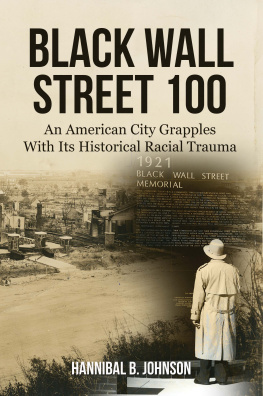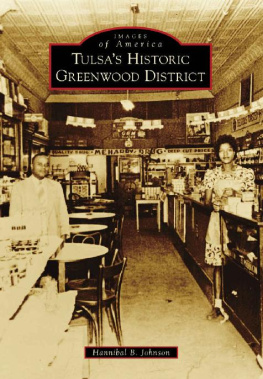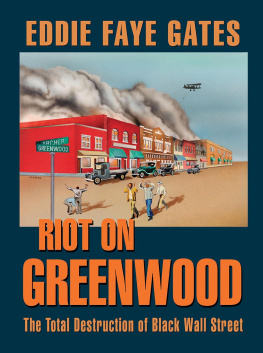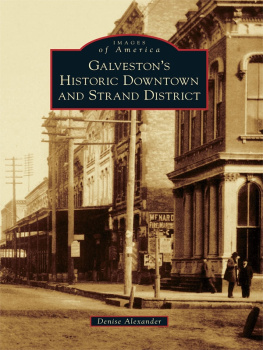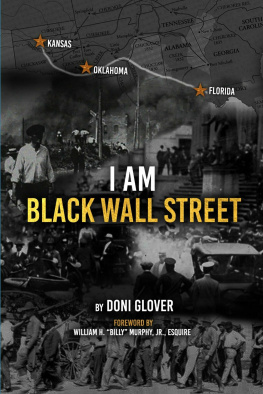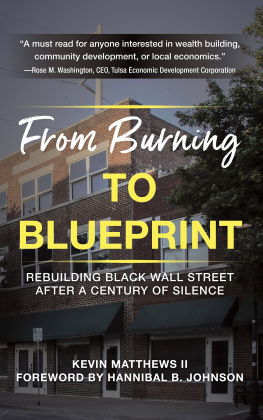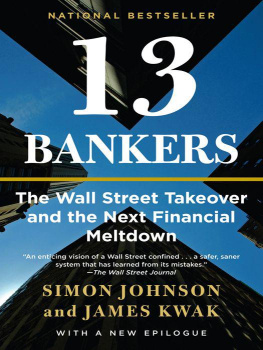Hannibal B. Johnson - Black Wall Street: From Riot to Renaissance in Tulsas Historic Greenwood District
Here you can read online Hannibal B. Johnson - Black Wall Street: From Riot to Renaissance in Tulsas Historic Greenwood District full text of the book (entire story) in english for free. Download pdf and epub, get meaning, cover and reviews about this ebook. year: 2014, publisher: Eakin Press, genre: Detective and thriller. Description of the work, (preface) as well as reviews are available. Best literature library LitArk.com created for fans of good reading and offers a wide selection of genres:
Romance novel
Science fiction
Adventure
Detective
Science
History
Home and family
Prose
Art
Politics
Computer
Non-fiction
Religion
Business
Children
Humor
Choose a favorite category and find really read worthwhile books. Enjoy immersion in the world of imagination, feel the emotions of the characters or learn something new for yourself, make an fascinating discovery.
- Book:Black Wall Street: From Riot to Renaissance in Tulsas Historic Greenwood District
- Author:
- Publisher:Eakin Press
- Genre:
- Year:2014
- Rating:4 / 5
- Favourites:Add to favourites
- Your mark:
- 80
- 1
- 2
- 3
- 4
- 5
Black Wall Street: From Riot to Renaissance in Tulsas Historic Greenwood District: summary, description and annotation
We offer to read an annotation, description, summary or preface (depends on what the author of the book "Black Wall Street: From Riot to Renaissance in Tulsas Historic Greenwood District" wrote himself). If you haven't found the necessary information about the book — write in the comments, we will try to find it.
Black Wall Street: From Riot to Renaissance in Tulsas Historic Greenwood District — read online for free the complete book (whole text) full work
Below is the text of the book, divided by pages. System saving the place of the last page read, allows you to conveniently read the book "Black Wall Street: From Riot to Renaissance in Tulsas Historic Greenwood District" online for free, without having to search again every time where you left off. Put a bookmark, and you can go to the page where you finished reading at any time.
Font size:
Interval:
Bookmark:


Library of Congress Cataloging-in-Publication Data
Johnson, Hannibal B.
Black Wall Street : from riot to renaissance in Tulsas historic Greenwood District / Hannibal B. Johnson.
p. cm.
Includes bibliographical references and index.
1. Afro-AmericansOklahomaTulsaHistory. 2. Tulsa (Okla.)Race relations. 3. RiotsOklahomaTulsaHistory20th century. 4. Afro-AmericansOklahoma TulsaEconomic conditions. I. Title.
| 976.686dc21 | 97-51180 |
| CIP |
| Appendices | A: |
| B: | |
| C: | |
| D: | |
| E: | |
| F: |

COVER ART BY
CLAY PORTIS
Clay Portis is a San Francisco Bay Area artist specializing in pen & ink, watercolor, and acrylic media. His work has been shown in the San Francisco Bay Area and in Tulsa, Oklahoma. Clay studied at the San Francisco School of Arts on a full scholarship. His work ranges from sketches to comic book characters. Clays publications include Kane, an original comic book featuring an African-American superhero of the same name. For prints of the Black Wall Street cover, contact: Clay Portis, 1568 Vervais, Vallejo, California 94591; (707) 552-3951.
I join a host of others in commending Oklahoma State Senator Maxine Horner and Oklahoma State Representative Don Ross for their heroic contributions toward restoring Tulsas historic Greenwood District to at least a fraction of its original splendor. Their leadership and vision shaped the current renaissance.
Thanks to the following individuals and institutions for providing many of the archives and historical insights upon which this work is based: Dr. John Sibley Butler, Bettie Downing, Scott Ellsworth, Eddie Faye Gates, Jeanne B. Goodwin, James O. Goodwin, Esq., Jerry Goodwin, Jewell Hines, Millard House, Marian Jones, William D. LaFortune, Esq., Marcene Mackey, Judi Eason-McIntyre, Dr. Jilda Motley, Carmen Pettie, Robert Powers, Kavin Ross, George E. Schaefer, Shari Horner-Tisdale, and Josie Vann; the Business and Industrial Development Corporation, First Baptist Church of North Tulsa, the Greenwood Cultural Center, Mt. Zion Baptist Church, the North Tulsa Heritage Foundation, Inc., the Oklahoma Historical Society, the Oklahoma Jazz Hall of Fame, the Tulsa Historical Society, the University of Tulsa McFarlin Library, and Vernon Chapel A.M.E.
Turner Goodrums technical skills and keen sense of place and image produced stunning, evocative photographs. His discernment assisted greatly with the selection of the vintage photographs included in the book.
My immensely talented nephew, Clay Portis, designed the cover art for the book. His ability to conceptualize and translate experiences into compelling imagery never ceases to amaze.
Dr. Vivian Clark, Sarah Theobald-Hall, Lt. Lynn Jones, Kenneth J. Levit, Esq., Gary Pilgrim, Esq., Brenda Johnson Portis, and Adam Seaman provided thoughtful, constructive feedback on various drafts of this work. For those additional eyes I am enormously grateful.
Special thanks to: David L. Boren, president of the University of Oklahoma; Sanford Cloud, Jr., president & CEO of the National Conference for Community and Justice (formerly the National Conference of Christians and Jews); Dr. John Hope Franklin, James B. Duke Professor of History Emeritus, Duke University; Frank Keating, governor of the state of Oklahoma; Wilma Mankiller, former chief of the Cherokee Nation; M. Susan Savage, mayor of the city of Tulsa; and Rabbi Charles P. Sherman, Temple Israel, Tulsa. These individuals reviewed the book and provided comments.
Steve Walkers assistance with data entry helped enormously.
Friends Cheryl Brown, Judith A. Colbert, Esq., Nancy Day, Pinkie Farver, Sharon Gallagher, Lawrence A. Hall, Esq., Marvin Love, Calvin Moore, Esq., Loretta Radford, Esq., Rosetta Ross, and Fred Yette, Esq., provided much-needed continuity throughout the course of this writing.
Thanks to my parents, Bernice and Frank Johnson, whose love, encouragement, and support have never waned.
I set out on this stroll through Tulsas famed Greenwood District, past and present, on a mission: to discover for myself the remarkable history of a community and to share my findings with the world. I did not walk alone. I offer a special thank you to those African-American pioneers, living and dead, who journeyed with me and upon whose shoulders I now stand. May our stewardship of their legacy honor their lives and memories for generations to come.
We must accept finite disappointment,
but we must never lose infinite hope.
DR. MARTIN LUTHER KING, JR.
The bittersweet story of Tulsas historic Greenwood District, once considered The Negro Wall Street, is a tale of tragedy and triumph, oppression and opportunity, despair and dignity. It is a real-life human drama, set in a city dubbed the Oil Capital of the World, starring a cast of African-American heroes whose courage, ingenuity, and faith sustained them through lifes highest peaks and lowest valleys. It is, above all, a testament to the power of hope and a tribute to the resilience of the human spirit. Just how these African-American pioneers managed to transform the undeveloped land just north of the Frisco Railroad tracks into a thriving Midwest mecca, revive it from the ruinous Tulsa Race Riot of 1921, and set in motion its current rebirth remains one of the best kept secrets in America. Most Americans, and many Tulsans, native and otherwise, remain oblivious to the lasting historical significance of the Greenwood District.
The history of the Greenwood District may be viewed in four phases: (1) The Roots; (2) The Riot; (3) The Regeneration; and (4) The Renaissance. Thus viewed, the rich past of the Greenwood District evokes virtually every human emotion pain and pride, horror and hope, regret and remembrance.
The true spirit of the Greenwood District pioneers is illustrated by the following exchange of letters between Curtis, a man in Detroit, and Oliver, his friend in Tulsa, in the immediate wake of the Tulsa Race Riot of 1921.
Dear Oliver:
I am, by our local newspaper, fully advised of the whole terrible tragedy there. Now that they have destroyed your homes, wrecked your schools, churches and business places, and killed your people, I am sure that the Negroes will rapidly give up the town and move North. Enclosed, please find draft for $40.00 to purchase your ticket to Detroit.
Will be expecting you.
CURTIS.
Dear Curtis:
How kind of you to volunteer your sympathetic assistance. It is just like you to be helpful to others in time of stress like this.
True it is, we are facing a terrible situation. It is equally true that they have destroyed our homes; they have wrecked our schools; they have reduced our churches to ashes and they have murdered our people, Curtis; but they have not touched our spirit. And while I speak only for myself, let it be said that I came here and built my fortune with that SPIRIT, I shall reconstruct it here with that SPIRIT, and I expect to live on and die here with it.
OLIVER.
The lessons of this fragment of American history are legion. Few are more compelling and relevant than the realization that the human spirit may bend, but it need not break. Under the most severe of lifes tests, in our darkest hours, faith and hope and fortitude work minor miracles. Every Oklahomanindeed, every Americanshould take the time to learn how Tulsas Greenwood District developed into one of the most prosperous African-American communities in the country, survived the worst race riot in United States history, literally rebuilt itself from ruins, and is now enjoying a long overdue renaissance.
Font size:
Interval:
Bookmark:
Similar books «Black Wall Street: From Riot to Renaissance in Tulsas Historic Greenwood District»
Look at similar books to Black Wall Street: From Riot to Renaissance in Tulsas Historic Greenwood District. We have selected literature similar in name and meaning in the hope of providing readers with more options to find new, interesting, not yet read works.
Discussion, reviews of the book Black Wall Street: From Riot to Renaissance in Tulsas Historic Greenwood District and just readers' own opinions. Leave your comments, write what you think about the work, its meaning or the main characters. Specify what exactly you liked and what you didn't like, and why you think so.


